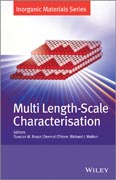
Multi Length-Scale Characterisation
Bruce, Duncan W.
O?Hare, Dermot
Walton, Richard I.
Whereas the first five volumes in the Inorganic Materials Series focused on particular classes of materials (synthesis, structures, chemistry, and properties), it is now very timely to provide complementary volumes that introduce and review state–of–the–art techniques for materials characterization. This is an important way of emphasizing the interplay of chemical synthesis and physical characterization. The methods reviewed include spectroscopic, diffraction, and surface techniques that examine the structure of materials on all length scales, from local atomic structure to long–range crystallographic order, and are written by experts from around the world. INDICE: Inorganic Materials Series Preface xi Preface xiii List of Contributors xv 1 Measurement of Bulk Magnetic Properties 1 Scott Turner 1.1 Introduction 1 1.1.1 Purpose and Scope 3 1.1.2 The Origin of Magnetic Properties 4 1.1.3 The Units of Magnetism 8 1.1.4 Magnetism due to Paired Electrons 10 1.1.5 Magnetism due to Unpaired Electrons 12 1.1.6 Magnetic Materials with Long–Range Order 23 1.1.7 Brief Notes on Other Types of Magnetism 30 1.1.8 General Considerations for the Measurement of Magnetic Properties 33 1.2 Magnetic Measurement based on Measuring a Force or Torque 34 1.2.1 The Gouy Balance 34 1.2.2 The Evans Balance (or Inverse Gouy Method) 36 1.2.3 The Faraday Balance 38 1.3 Magnetic Measurement based on Induction 38 1.3.1 The DC SQUID Magnetometer 38 1.3.2 AC Magnetometry 49 1.3.3 The Micro (and Nano)–SQUID 52 1.3.4 The Vibrating Sample Magnetometer (VSM) 52 1.4 The Evans NMR Method 53 1.5 Brief Notes on Complementary Techniques 54 1.5.1 Electron Paramagnetic Resonance 54 1.5.2 Ultraviolet–Visible Spectroscopy 55 1.5.3 Thermal Techniques 56 1.5.4 Mössbauer Spectroscopy 56 1.5.5 Measuring Local Magnetic Fields with Muons and Neutrons 57 References 59 2 Thermal Methods 63 Michel B. Johnson and Mary Anne White 2.1 Introduction 63 2.2 Thermal Analysis 64 2.2.1 Thermogravimetric Analysis 64 2.2.2 Differential Thermal Analysis 67 2.2.3 Differential Scanning Calorimetry 74 2.2.4 Example of a Coupled Thermoanalytical Technique 83 2.2.5 Concluding Comments Concerning Thermal Analysis 84 2.3 Heat Capacity 85 2.3.1 Background 85 2.3.2 Adiabatic Calorimetry 86 2.3.3 Relaxation Calorimetry 87 2.3.4 Other Heat–Capacity Methods 90 2.3.5 Estimation of Heat Capacity 92 2.4 Thermal Conductivity 95 2.4.1 Background 95 2.4.2 Steady–State Method 97 2.4.3 Guarded Hot Plate Method 99 2.4.4 Parallel Thermal Conductance Method 100 2.4.5 Power–Pulse Method 102 2.4.6 Laser–Flash Diffusivity 103 2.4.7 Hot–Wire Method 105 2.4.8 3 Method 106 2.5 Thermal Expansion 108 2.5.1 Terminology and Atomic Origins 108 2.5.2 Diffraction Methods 110 2.5.3 Dilatometry 111 2.6 Conclusion 114 References 115 3 Atomic Force Microscopy 121 Pablo Cubillas and Michael W. Anderson 3.1 Introduction 121 3.2 History 122 3.3 The Basics of How AFM Works 123 3.3.1 Instrument Architecture 123 3.3.2 Basic Scanning Modes 127 3.3.3 Cantilevers and Tips 133 3.3.4 Image Artefacts 140 3.3.5 Scanning Environment 145 3.3.6 Sample Preparation 146 3.4 Important Developments in AFM 146 3.4.1 Tip Functionalisation/Chemical Force Microscopy 146 3.4.2 Nanotubes as Nanoprobes 147 3.4.3 Frequency Modulation 148 3.4.4 Higher Harmonics 149 3.4.5 Atomic Resolution 150 3.4.6 Hydrothermal AFM 151 3.4.7 Video–Rate AFM 152 3.4.8 Active Cantilevers 153 3.4.9 Dip–Pen Nanolithography 154 3.4.10 Scanning Near–Field Optical Microscopy 154 3.4.11 Raman/AFM 155 3.5 Specialised Scanning Modes 156 3.5.1 Phase Imaging 156 3.5.2 Force–Modulation AFM 156 3.5.3 Friction Force Microscopy 157 3.5.4 Force Volume 159 3.5.5 Magnetic Force Microscopy 159 3.5.6 Electric Force Microscopy 161 3.5.7 Kelvin–Probe Force Microscopy 162 3.5.8 Piezoresponse Force Microscopy 162 3.5.9 Nanoindenting 163 3.6 Applications 164 3.6.1 General Considerations 164 3.6.2 Atomic–Resolution, Non–Contact AFM of Metal Oxides 165 3.6.3 Atomic–Resolution, Frequency–Modulated AFM in Liquids 172 3.6.4 Crystal Growth 175 3.6.5 Atom Manipulation with AFM 180 3.6.6 Data Storage 181 3.6.7 Oxide Epitaxial Overgrowths 183 3.6.8 Hydrothermal AFM 184 References 185 4 Gas Sorption in the Analysis of Nanoporous Solids 195 Philip Llewellyn 4.1 Introduction 195 4.2 What is Adsorption, Why do Fluids Adsorb and How Can Adsorption Phenomena be Visualised? 198 4.3 Adsorption Experiments 204 4.3.1 Adsorption Devices 204 4.3.2 Experimental Protocol 205 4.4 Interpretation of Isotherms to Estimate Porous Solid Characteristics 212 4.4.1 Evaluation of Isotherm Type and Shape 212 4.4.2 Evaluation of Specific Surface Area using the BET Model 216 4.4.3 Evaluation of External Surface Area and Pore Volume using the t– or S–Method 218 4.4.4 Evaluation of Micropore Size: The Horwath– Kawazoe Methodology 222 4.4.5 Evaluation of both Micropore and Mesopore Size using DFT/GCMC Treatment and Isotherm Reconstruction 224 4.5 Conclusion 227 References 229 5 Dynamic Light Scattering 233 Erika Eiser 5.1 Introduction 233 5.2 Theoretical Background 235 5.2.1 Scattering Intensities and the Autocorrelation Function 243 5.2.2 Homodyne versus Heterodyne Detection 247 5.2.3 Relations between the Correlation Functions and Static Light Scattering 249 5.3 Applications 250 5.3.1 Particle Sizing 250 5.3.2 Identical Spherical Colloids in Dilute Suspensions 251 5.3.3 Particle Sizing in Realistic Systems: Size Distributions 253 5.3.4 Dense Systems 261 5.4 Instrumental Developments and New Methods 262 5.4.1 Fibre–Optic DLS 262 5.4.2 Differential Dynamic Microscopy 264 5.5 Physical Chemistry Applications 272 5.5.1 Particle Sizing Revisited 273 5.5.2 Quantum Dots, Gold and Other Nanocrystals 274 5.5.3 Self–Assembling Systems: Micelles, Vesicles and Other Equilibrium Structures 276 5.6 Conclusion 279 References 279 Index 283
- ISBN: 978-1-119-95319-7
- Editorial: Wiley–Blackwell
- Encuadernacion: Cartoné
- Páginas: 312
- Fecha Publicación: 31/01/2014
- Nº Volúmenes: 1
- Idioma: Inglés
